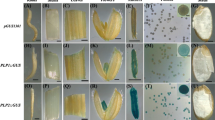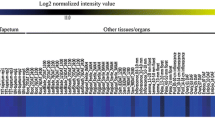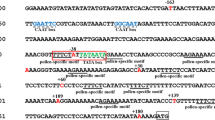Abstract
The tobacco gene g10 is preferentially and maximally expressed in mature pollen, shows homology to pectate lyases, and is the putative homologue of the tomato gene lat56. Analysis of regulatory elements within the g10 promoter was carried out to verify the importance of putative regulatory sequence motifs. Analysis of transgenic plants showed that 1190 bp of g10 5′ sequence directed preferential expression of GUS in pollen, with bimodal peaks of expression just before and during pollen mitosis I, and in mature anthers. This was confirmed by northern analysis of native g10 transcripts in isolated spores. Transient expression analysis defined the minimal g10 promoter region capable of directing expression in pollen as −86 to +217. Three upstream regions within −427 bp modulate the expression from g10. Gain-of-function analyses showed that the region from −106 to −53 could enhance pollen-specific expression of a minimal CaMV 35S promoter. These analyses further showed that sequences upstream of −86 modulate expression in pollen, but are not essential for preferential pollen expression. The function of a conserved GTGA motif shared between the tobacco g10 and tomato lat56 promoters was demonstrated in g10. Thus, further functional evidence is provided for the conservation of mechanisms for the regulation of late pollen genes across species.
Similar content being viewed by others
References
Bate, N. and Twell, D. 1998. Functional architecture of a late pollen promoter: pollen-specific transcription is developmentally regulated by multiple stage-specific and co-dependent activator elements. Plant Mol. Biol. 37: 859–869.
Brown, S.M. and Crouch, M.L. 1990. Characterisation of a gene family abundantly expressed in Oenothera organensis pollen that shows sequence similarity to polygalacturonase. Plant Cell 2: 263–274.
Carrington, J.C. and Freed D.D. 1990. Cap-independent enhancement of translation by a plant potyvirus 5′ non-translated region. J. Virol. 64: 1590–1597.
Eyal, Y., Curie, C. and McCormick, S. 1995. Pollen specificity elements reside in 30 bp of the proximal promoters of two pollen-expressed genes. Plant Cell 7: 373–384.
Horsch, R., Fry, J., Hoffman, N., Eichholtz, D., Rogers, S. and Fraley R. 1985. A simple and general method for transferring genes into plants. Science 227: 1229–1231.
Jefferson, R.A 1987. Assaying chimeric genes in plants: the GUS gene fusion system. Plant Mol. Biol. Rep. 5: 387–405.
Lonsdale, D.M., Allen, R.L., Belostotsky, D., Ghose, T.K., Harvey, A.J., Rogers, H.J., Tebbutt, S.J. and Trick, M. 1995. An analysis of the relative activities of a number of promoter constructs from genes which are expressed during late pollen development as determined by particle bombardment. Plant Cell Rep. 15: 154–158.
Mu, J.H., Stains, J.P. and Kao, T. 1994. Characterization of a pollen-expressed gene encoding a putative pectin esterase of Petunia inflata. Plant Mol. Biol. 25: 539–544.
Murphy, G. and Kavanagh, T.A. 1988. Speeding up the sequencing of double-stranded DNA. Nucl. Acids. Res. 16: 5198.
Niogret, M.F., Dubald, M., Mandaron, P. and Mache, R. 1991. Characterisation of pollen polygalacturonase encoded by several cDNA clones in maize. Plant Mol. Biol. 17: 1155–1164.
Rogers, H.J. and Lonsdale,. DM. 1992. Genetic manipulation for the production of hybrid seed. Plant Growth Regul. 11: 21–26.
Rogers, H.J., Harvey, A. and Lonsdale, D.M. 1992. Isolation and characterisation of a tobacco gene with homology to pectate lyase which is specifically expressed during microsporogenesis. Plant Mol. Biol. 20: 493–502.
Sweetman, J., Spurr, C., Eliasson, A., Gass, N., Steinmetz, A. and Twell, D. 2000. Isolation and characterisation of two pollen-specific LIM domain protein cDNAs from Nicotiana tabacum. Sex Plant Reprod. 12: 339–345.
Taniguchi, Y., Ono, A., Sawatani, M., Nanba, M., Kohno, K., Usui, H., Kurimoto, M. and Matuhasi, T. 1995. Cry-j-I, a major allergen of Japanese cedar pollen, has pectate lyase enzyme-activity. Allergy 50: 90–93.
Taylor, L.P. and Hepler, P.K. 1997. Pollen germination and tube growth. Annu. Rev. Plant Physiol. Plant Mol. Biol. 48: 461–491.
Twell, D. 1994. The diversity and regulation of gene expression in the pathway of male gametophyte development. In: R.J. Scott and A.D. Stead (Eds.) Molecular and Cellular Aspects of Plant Reproduction, Cambridge University Press, Cambridge, UK pp. 83–115.
Twell, D., Klein, T.M., Fromm, M.E. and McCormick, S. 1989a. Transient expression of chimeric genes delivered into pollen by microprojectile bombardment. Plant Physiol. 91: 1270–1274.
Twell, D., Wing, R., Yamaguchi, J. and McCormick, S. 1989b. Isolation and expression of an anther-specific gene from tomato. Mol. Gen. Genet. 217: 240–245.
Twell, D., Yamaguchi, J. and McCormick, S. 1990. Pollen-specific gene-expression in transgenic plants: coordinate regulation of two different tomato gene promoters during microsporogenesis. Development 109: 705–713.
Twell, D., Yamaguchi, J., Wing, R.A., Ushiba, J. and McCormick, S. 1991. Promoter analysis of genes that are coordinately expressed during pollen development reveals pollen-specific enhancer sequences and shared regulatory elements. Genes Dev. 5: 496–507.
Van Gijsegem, F. 1989. Relationship between the pel genes of the pelADE cluster in Erwinia chrysanthemi strain B374. Mol. Microbiol. 3: 1415–1424.
Wakeley, P.R., Rogers, H.J., Rozycka, M., Greenland, A.J. and Hussey, P.J. 1998. A maize pectin methylesterase-like gene, ZmC5, specifically expressed in pollen. Plant Mol. Biol. 37: 187–192.
Willing, R.P., Bashe, D. and Mascarenhas, J.P. 1988. An analysis of the quantity and diversity of messenger-RNAs from pollen and shoots of Zea mays. Theor. Appl. Genet. 75: 751–753.
Willing, R.P. and Mascarenhas, J.P. 1984. Analysis of the complexity and diversity of mRNAs from pollen and shoots of Tradescantia. Plant Physiol. 75: 865–868.
Wing, R.A., Yamaguchi, J., Larabell, S.K., Ursin, V.M. and McCormick, S. 1989. Molecular and genetic characterisation of two pollen expressed genes that have sequence similarity to pectate lyases of the plant pathogen Erwinia. Plant Mol. Biol. 14: 17–28.
Author information
Authors and Affiliations
Rights and permissions
About this article
Cite this article
Rogers, H., Bate, N., Combe, J. et al. Functional analysis of cis-regulatory elements within the promoter of the tobacco late pollen gene g10. Plant Mol Biol 45, 577–585 (2001). https://doi.org/10.1023/A:1010695226241
Issue Date:
DOI: https://doi.org/10.1023/A:1010695226241




